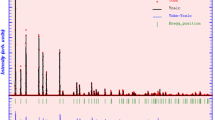Abstract
Energy losses below 100 eV are by far less exploited than higher losses in electron energy-loss spectroscopy. Two new examples are given to illustrate the characterization possibilities offered by spectra in this energy range. Typical materials that could be used as electrodes in electrochemical cells were chosen as application cases. Through the use of calculations based on density functional theory, we first demonstrate that the first peak present at the lithium K edge in Li x TiP4 can give access to the precise localisation of inserted Li atoms in the f.c.c. structure. In particular, different tetrahedral sites could be differentiated according to their distance to the Ti site. Secondly, calculations of valence electron energy-loss spectra of perovskite materials indicate that a characteristic peak for regular perovskite (Pm \(\overline 3 \)m space group) exists in the 10–15 eV range. The high sensitivity of this peak to the distortion of the octahedron arrangements is also demonstrated.





Similar content being viewed by others
References
Egerton RF (1996) Electron energy-loss spectroscopy in the electron microscope. Plenum, New York
Ahn CC (2004) Transmission Electron Energy Loss Spectrometry in Materials Science and the EELS atlas. Wiley-VCH
Daniels HR, Brydson R, Brown A, Rand B (2003) Ultramicroscopy proceedings of the international workshop on strategies and advances in atomic level spectroscopy and analysis 96:547–558
Grigis C, Schamm S (1998) Ultramicroscopy 74:159–167
Knupfer M, Fink J (2004) Synthetic Metals 141:21–27
Marini A, Del Sole R, Rubio A (2003) Phys Rev Lett 91:256402
Tafto J, Krivanek OL (1982) Phys Rev Lett 48:560–563
Pearson DHAhn CC, Fultz B (1993) Phys Rev B 47:8471–8478
Gloter A, Serin V, Turquat C, Cesari C, Leroux C, Nihoul G (2001) Eur Phys J B 22:179
Lie K, Hoier R, Brydson R (2000) Phys Rev B 61:1786–1794
Graetz J, Hightower A, Ahn CC, Yazami R, Rez P, Fultz B (2002) J Phys Chem B 106:1286–1289
Shiraishi Y, Nakai I, Kimoto K, Matsui Y (2001) J Power Sources 97-98:461–464
Backhaus-Ricoult M (2006) Solid State Ionics Solid State Ionics 15: Proceedings of the 15th International Conference on Solid State Ionics, Part I 177:2195–2200
Rez P, Bruley J, Brohan P, Payne M, Garvie LAJ (1995) Ultramicroscopy 59:159–167
Hébert C, Luitz J, Schattschneider P (2003) Micron 34:219–225
Blaha P, Schwarz K, Madsen GKH, Kvaniscka D, Luitz J (2001) WIEN2k, An Augmented Plane Wave + Local Orbitals Program for Calculating Crystal Properties. Schwarz K., Techn. Universität Wien, Austria
Hohenberg P, Kohn W (1964) Phys Rev 136:B864–B871
Kohn W, Sham LJ (1965) Phys Rev 140:A1133–A1138
Keast VJ (2005) J Electron Spectrosc Relat Phenom 143:97
Launay M, Boucher F, Moreau P (2004) Phys Rev B 69:035101–035109
Mauchamp V, Boucher F, Ouvrard G, Moreau P (2006) Phys Rev B 74:115106–115110
Singh DJ (1994) Planewaves, pseudopotentials and the LAPW method. Kluwer Academic
Cottenier S (2002) Density Functional Theory and the Family of (L)APW-Methods: A Step-by-Step Introduction-Instituut voor kern-en Stralingsfysica, K. U. Leuven, Belgium, 2002, to be found at http://www.wien2k.at/reguser/textbooks
Perdew JP, Burke K, Ernzerhof M (1996) Phys Rev Lett 77:3865–3868
Blöchl PE, Jepsen O, Andersen OK (1994) Phys Rev B 49:16223–16233
Ambrosch-Draxl C, Majewski JA, Vogl P, Leising G (1995) Phys Rev B 51:9668–9676
Ambrosch-Draxl C, Sofo J (2006) Comp Phys Comm 175:1
Doublet M-L, Lemoigno F, Gillot F, Monconduit L (2002) Chem Mater 14:4126–4133
Bichat M-P, Gillot F, Monconduit L, Favier F, Morcrette M, Lemoigno F, Doublet M-L (2004) Chem Mater 16:1002–1013
NIST/FIZ, Inorganic Crystal Structure Database (2007) Version 1.4.2
Mauchamp V, Moreau P, Monconduit L, Doublet M-L, Boucher F, Ouvrard G (2007) J Phys Chem. C 111:3996–4002
Fallon P, Walsh CA, PEELS programme (1996) University of Cambridge, UK
Mitterbauer C, Kothleitner G, Grogger W, Zandbergen H, Freitag B, Tiemeijer P, Hofer F (2003) Ultramicroscopy 96:469–480 Profceedings of the International Workshop on Strategies and Advances in Atomic Level Spectroscopy and Analysis
Rafferty B, Brown LM (1998) Phys Rev B 58:10326
Ferrari AC, Libassi A, Tanner BK, Stolojan V, Yuan J, Brown LM, Rodil SE, Kleinsorge B, Robertson J (2000) Phys Rev B 62:11089–11103
Grey CP, Dupre N (2004) Chem Rev 104:4493–4512
Acknowledgments
We would also like to thank Dr. Laure Monconduit and Dr. M-L Doublet (Institut Charles Gerhardt, University of Montpellier, France) for providing the samples and for very fruitful discussions.
Author information
Authors and Affiliations
Corresponding author
Additional information
Paper presented at the 11th EuroConference on the Science and Technology of Ionics, Batz-sur-Mer, Sept. 9–15, 2007.
Rights and permissions
About this article
Cite this article
Mauchamp, V., Boucher, F. & Moreau, P. Electron energy-loss spectroscopy in the low-loss region as a characterization tool of electrode materials. Ionics 14, 191–195 (2008). https://doi.org/10.1007/s11581-008-0208-1
Received:
Revised:
Accepted:
Published:
Issue Date:
DOI: https://doi.org/10.1007/s11581-008-0208-1




